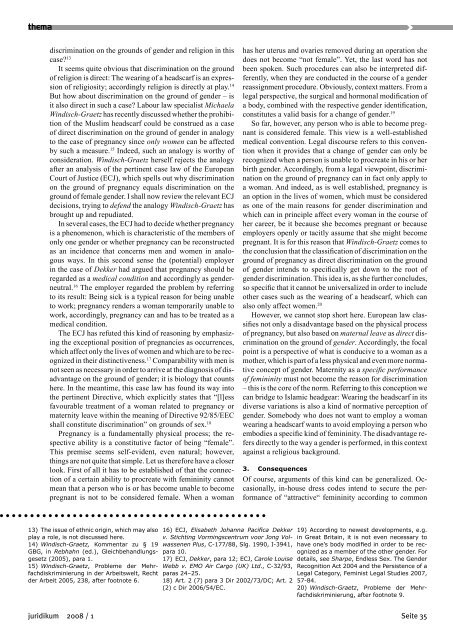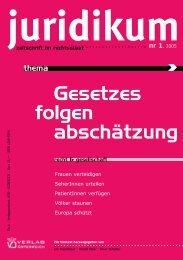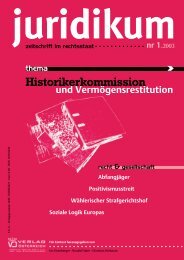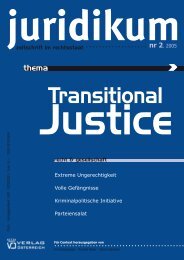Download - juridikum, zeitschrift für kritik | recht | gesellschaft
Download - juridikum, zeitschrift für kritik | recht | gesellschaft
Download - juridikum, zeitschrift für kritik | recht | gesellschaft
Erfolgreiche ePaper selbst erstellen
Machen Sie aus Ihren PDF Publikationen ein blätterbares Flipbook mit unserer einzigartigen Google optimierten e-Paper Software.
thema<br />
discrimination on the grounds of gender and religion in this<br />
case? 13<br />
It seems quite obvious that discrimination on the ground<br />
of religion is direct: The wearing of a headscarf is an expression<br />
of religiosity; accordingly religion is directly at play. 14<br />
But how about discrimination on the ground of gender – is<br />
it also direct in such a case? Labour law specialist Michaela<br />
Windisch-Graetz has recently discussed whether the prohibition<br />
of the Muslim headscarf could be construed as a case<br />
of direct discrimination on the ground of gender in analogy<br />
to the case of pregnancy since only women can be affected<br />
by such a measure. 15 Indeed, such an analogy is worthy of<br />
consideration. Windisch-Graetz herself rejects the analogy<br />
after an analysis of the pertinent case law of the European<br />
Court of Justice (ECJ), which spells out why discrimination<br />
on the ground of pregnancy equals discrimination on the<br />
ground of female gender. I shall now review the relevant ECJ<br />
decisions, trying to defend the analogy Windisch-Graetz has<br />
brought up and repudiated.<br />
In several cases, the ECJ had to decide whether pregnancy<br />
is a phenomenon, which is characteristic of the members of<br />
only one gender or whether pregnancy can be reconstructed<br />
as an incidence that concerns men and women in analogous<br />
ways. In this second sense the (potential) employer<br />
in the case of Dekker had argued that pregnancy should be<br />
regarded as a medical condition and accordingly as genderneutral.<br />
16 The employer regarded the problem by referring<br />
to its result: Being sick is a typical reason for being unable<br />
to work; pregnancy renders a woman temporarily unable to<br />
work, accordingly, pregnancy can and has to be treated as a<br />
medical condition.<br />
The ECJ has refuted this kind of reasoning by emphasizing<br />
the exceptional position of pregnancies as occurrences,<br />
which affect only the lives of women and which are to be recognized<br />
in their distinctiveness. 17 Comparability with men is<br />
not seen as necessary in order to arrive at the diagnosis of disadvantage<br />
on the ground of gender; it is biology that counts<br />
here. In the meantime, this case law has found its way into<br />
the pertinent Directive, which explicitly states that “[l]ess<br />
favourable treatment of a woman related to pregnancy or<br />
maternity leave within the meaning of Directive 92/85/EEC<br />
shall constitute discrimination” on grounds of sex. 18<br />
Pregnancy is a fundamentally physical process; the respective<br />
ability is a constitutive factor of being “female”.<br />
This premise seems self-evident, even natural; however,<br />
things are not quite that simple. Let us therefore have a closer<br />
look. First of all it has to be established of that the connection<br />
of a certain ability to procreate with femininity cannot<br />
mean that a person who is or has become unable to become<br />
pregnant is not to be considered female. When a woman<br />
has her uterus and ovaries removed during an operation she<br />
does not become “not female”. Yet, the last word has not<br />
been spoken. Such procedures can also be interpreted differently,<br />
when they are conducted in the course of a gender<br />
reassignment procedure. Obviously, context matters. From a<br />
legal perspective, the surgical and hormonal modification of<br />
a body, combined with the respective gender identification,<br />
constitutes a valid basis for a change of gender. 19<br />
So far, however, any person who is able to become pregnant<br />
is considered female. This view is a well-established<br />
medical convention. Legal discourse refers to this convention<br />
when it provides that a change of gender can only be<br />
recognized when a person is unable to procreate in his or her<br />
birth gender. Accordingly, from a legal viewpoint, discrimination<br />
on the ground of pregnancy can in fact only apply to<br />
a woman. And indeed, as is well established, pregnancy is<br />
an option in the lives of women, which must be considered<br />
as one of the main reasons for gender discrimination and<br />
which can in principle affect every woman in the course of<br />
her career, be it because she becomes pregnant or because<br />
employers openly or tacitly assume that she might become<br />
pregnant. It is for this reason that Windisch-Graetz comes to<br />
the conclusion that the classification of discrimination on the<br />
ground of pregnancy as direct discrimination on the ground<br />
of gender intends to specifically get down to the root of<br />
gender discrimination. This idea is, as she further concludes,<br />
so specific that it cannot be universalized in order to include<br />
other cases such as the wearing of a headscarf, which can<br />
also only affect women. 20<br />
However, we cannot stop short here. European law classifies<br />
not only a disadvantage based on the physical process<br />
of pregnancy, but also based on maternal leave as direct discrimination<br />
on the ground of gender. Accordingly, the focal<br />
point is a perspective of what is conducive to a woman as a<br />
mother, which is part of a less physical and even more normative<br />
concept of gender. Maternity as a specific performance<br />
of femininity must not become the reason for discrimination<br />
– this is the core of the norm. Referring to this conception we<br />
can bridge to Islamic headgear: Wearing the headscarf in its<br />
diverse variations is also a kind of normative perception of<br />
gender. Somebody who does not want to employ a woman<br />
wearing a headscarf wants to avoid employing a person who<br />
embodies a specific kind of femininity. The disadvantage refers<br />
directly to the way a gender is performed, in this context<br />
against a religious background.<br />
3. Consequences<br />
Of course, arguments of this kind can be generalized. Occasionally,<br />
in-house dress codes intend to secure the performance<br />
of “attractive“ femininity according to common<br />
13) The issue of ethnic origin, which may also<br />
play a role, is not discussed here.<br />
14) Windisch-Graetz, Kommentar zu § 19<br />
GBG, in Rebhahn (ed.), Gleichbehandlungsgesetz<br />
(2005), para 1.<br />
15) Windisch-Graetz, Probleme der Mehrfachdiskriminierung<br />
in der Arbeitswelt, Recht<br />
der Arbeit 2005, 238, after footnote 6.<br />
16) ECJ, Elisabeth Johanna Pacifica Dekker<br />
v. Stichting Vormingscentrum voor Jong Volwassenen<br />
Plus, C-177/88, Slg. 1990, I-3941,<br />
para 10.<br />
17) ECJ, Dekker, para 12; ECJ, Carole Louise<br />
Webb v. EMO Air Cargo (UK) Ltd., C-32/93,<br />
paras 24–25.<br />
18) Art. 2 (7) para 3 Dir 2002/73/DC; Art. 2<br />
(2) c Dir 2006/54/EC.<br />
19) According to newest developments, e.g.<br />
in Great Britain, it is not even necessary to<br />
have one’s body modified in order to be recognized<br />
as a member of the other gender. For<br />
details, see Sharpe, Endless Sex. The Gender<br />
Recognition Act 2004 and the Persistence of a<br />
Legal Category, Feminist Legal Studies 2007,<br />
57-84.<br />
20) Windisch-Graetz, Probleme der Mehrfachdiskriminierung,<br />
after footnote 9.<br />
<strong>juridikum</strong> 2008 / 1 Seite 35
















